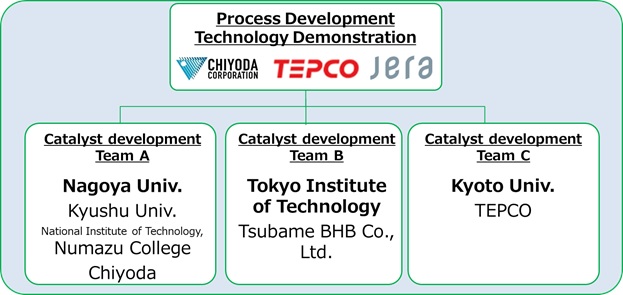JERA targets 50% ammonia-coal co-firing by 2030
By Julian Atchison on January 21, 2022
Four critical ammonia energy projects included in new funding announcement

Japanese government funding via NEDO (the New Energy and Industrial Technology Development Organisation) will support four critical ammonia energy projects, including JERA’s new plan to demonstrate 50% ammonia-coal co-firing by 2030.
These four projects will receive funding as part of a larger umbrella scheme named the “Fuel Ammonia Supply Chain Construction Project” (Japanese language), which has a budget of $500 million. This umbrella scheme – devised in close consultation between NEDO & METI – is slated to run until 2030 and aims to:
- reduce the supply cost of ammonia to “the high 10-Yen range per m3 [hydrogen equivalents]” by 2030. This roughly converts to US$1-2/kg hydrogen.
- introduce 20-40 ammonia combustion units for electricity generation by 2030 (both co-firing and 100% ammonia-fed).
- solve technical difficulties preventing high efficiency, low cost ammonia synthesis.
- build a fuel ammonia supply chain which integrates production and consumption.
Reducing supply costs via catalyst improvements, electrolytic synthesis

Three partners – JERA, Chiyoda Corporation and Tokyo Electric Power Company – will lead the first project. They will oversee three joint industry-academic teams competing against each other to develop improved ammonia synthesis catalysts. Bench testing is due by 2025, with industrial testing and commercialisation to start in 2027. One of the teams – Tsubame & Tokyo Tech – has already been closely collaborating for some time (eg. proposing a breakthrough, Nickel-based catalyst in 2020) and will continue their R&D programs.
At the time of reporting, a second project phase – development of processes and facilities for low-temperature, low-pressure ammonia synthesis to compete with Haber Bosch – has yet to be mapped out, but will involve Idemitsu Kosan.
A new benchmark for co-firing: 50%
JERA and IHI are already collaborating on a much-reported ammonia-coal co-firing demonstration at Hekinan power plant. That demonstration – 20% ammonia co-firing in a pulverised coal boiler – is still scheduled for 2024. But, funding from NEDO has set a new benchmark, with the partners setting their sights on a new demonstration target: 50% ammonia. Together they will develop boiler technology to handle the increased co-firing rate (by 2024), with the new equipment to be installed and operating at Hekinan by 2028.
Increased benchmarks for co-firing also raises the important question of supply. 20% co-firing in a single 1 GW unit at a multi-unit coal power station requires 500,000 tonnes of ammonia every year. Extrapolating the new co-firing target across Japan’s existing coal fleet, 50 million tonnes of ammonia would be needed every year across the country just to meet co-firing fuel requirements. This is not to suggest a uniform and comprehensive transformation of coal power in Japan is imminent, but it’s clear the volumes of ammonia fuel needed in the future will continue to multiply. The 30 million tonnes per year ammonia import target set last year by METI looks like it might be revised upwards again – and very quickly!
100% ammonia-fed boilers
Last September we reported that Mitsubishi Power was in the process of developing a 100% ammonia-fed boiler for industrial heat applications. A new collaboration between its parent organisation Mitsubishi Heavy Industries and JERA will see the development of ammonia-fed “single fuel burners” suitable for installation at current coal power plants in Japan. “Verification” of these new boilers will occur at JERA’s coal power stations in 2028 with 50% ammonia fuel – the same year that similar demonstrations at Hekinan will be taking place with JERA and IHI’s boiler technology. The two parallel tracks for boiler technology R&D perhaps indicates that – similar to the improved ammonia synthesis catalyst R&D described above – a competitive or semi-competitive development plan is being pursued.
100% ammonia-powered gas turbines

The final project to be funded is a private-public partnership between IHI, the University of Tohoku and the National Institute of Advanced Industrial Science and Technology to commercialise a 100% ammonia-fed, 2 MW gas turbine. IHI’s ambitions in this space are not new – in fact they first demonstrated ammonia co-combustion in the same class of gas turbine back in 2019 – but this new project is focused on commercialising a turbine that runs on wholly liquid ammonia fuel, which offers obvious advantages to operators (as well as some technical challenges!).
Exporting Japanese ammonia energy solutions to Asia
And a new cooperation agreement between ASEAN countries will see Japan support other members to adopt their ammonia energy solutions, particularly coal co-firing. The wide-reaching cooperation agreement includes details for an “Asia Energy Transition Initiative”, which calls for ASEAN members to begin implementing decarbonisation technologies across the region this year.
First, we will support the promotion of renewable energy and energy management. In policy dialogues with ASEAN countries, Japan will elaborate challenges and necessary support based on Japan’s experiences, and promote public-private cooperation in the areas of distributed power sources utilizing renewables, power grid in light of decarbonization, and geothermal power generation.
Next is co-firing of ammonia in coal fueled power generation. The World’s attention is drawn to how coal power accounting for about 40% of power mix in ASEAN will transition to zero emission. Since last year, Japan is conducting demonstration of 20% co-firing. The goal is to achieve single fuel firing up to 100% by 2030. If coal fueled power can be zero-emission, it would make a huge contribution to the world’s Climate change issue.Japan’s Minister of Economy, Trade and Industry Haguida Koichi in his speech (translated for press) at the agreement launch, 10 Jan 2022
Last is realizing CCS in ASEAN. Currently at Gundih in Indonesia, feasibility study is underway, a very first CCS project under the Joint Crediting Mechanism. CCS holds a key to decarbonization in Asia. We definitely hope to realize CCS under Japan-ASEAN cooperation.